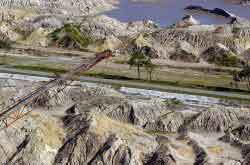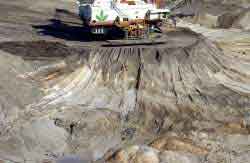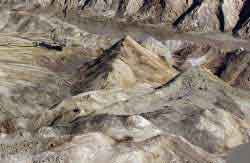|
About Bone Valley
Millions of years ago, river and streams flowing to the sea carried material washed from the land, including the remains of land animals and marine creatures inhabiting the coastal waters. Florida‚s phosphate rock reserves likely formed when dissolved phosphorous solidified and combined with sealife remains.
Geologists have dubbed the ancient fossil bed that now resides 20 to 40 feet below Central Florida as „Bone Valley.š It sits atop the Hawthorn Formation, a layer of clay and sandy limestone deposited long ago when the sea covered the state and the coastline curved around the modern-day Lake Wales Ridge as much as 60 miles inland. The Hawthorn Formation extends up the Atlantic Coast to North Carolina.
Bone Valley is a window to Florida‚s prehistoric past, when massive sharks and whales plied the waters, sharing the stage with land animals like the threetoed horse and giant sloth that are believed to have made the trek to North America from Asia across the Bering Strait land bridge when sea levels were lower.
Download a map which includes lands mined for phosphate since 1975, subject to mandatory reclamation. Reclamation of lands mined prior to 1975 (not included here) is voluntary. Although several companies are referenced in the legend, only three phosphate mining companies remain in Florida: Mosaic, CF Industries, and PCS Phosphates, located in northern Hamilton County. Only a few potential future mines are identified. In almost all cases, wherever a gypsum stack is noted, there is a fertilizer processing plant.

1. Digging for matrix: Phosphate ore is found 15 to 50 feet below ground in a mixture of sand, clay and phosphate rock known as matrix. After removing the top soil, draglines (huge cranes with buckets) scoop up the matrix and deposit it in a pit where high-pressure water guns create a slurry that can be pumped to a nearby beneficiation plant.
2. Extracting the phosphate: At the beneficiation plant, sand and clay are separated from the phosphate rock in a two-part process. Waste clay is pumped to settling ponds on site. Recovered sand is pumped back to the mine where it is used to backfill the mining pits. The rock then travels by truck or rail to a fertilizer processing plant.
3. Making fertilizer: Phosphate rock must be chemically processed before it can be used as a water-soluble fertilizer. At the processing plant, phosphate rock is mixed with sulfuric acid to create the phosphoric acid needed to make fertilizer. The chief end product is diammonium phosphate, which is made by reacting ammonia with phosphoric acid.
|
 |

Core samples obtained from deep wells around the state suggest that Florida may once have been part of Africa. More than 300 million years ago ų when the „super continentš scientists call Pangaea broke apart forming the continents we know today Ų the deep „basementš rocks remained with North America. Over the millions of years that followed, while most of what is now Florida was underwater, sedimentary deposits from the shells and skeletons of ancient marine creatures accumulated on top of the underlying rocks to form the land we see today. |
|


The largest shark in history to inhabit the ocean was the Megatooth shark, Carcharodon megalodon, which reached lengths of up to 80 feet. According to fossil records, sharks are one of the oldest species on earth dating back as far as 400 million years and were the first vertebrates to have jaws. This „Megš tooth was found at a phosphate mine near Riverview.
|
 |
 |
| |
4. How gypsum stacks up: Phosphogypsum is the slightly radioactive by-product of the chemical reaction or „wet processš that occurs when sulfuric acid reacts with phosphate to create phosphoric acid. EPA has banned the use of phosphogypsum in almost all circumstances because of its low-level radioactivity. Currently, there are more than a billion tons of phosphogypsum in 25 stacks in Florida. About 5 tons of phosphogypsum are produced for every ton of phosphoric acid.
5. Phosphate feeds the world: Florida provides about 75% of the phosphate fertilizer used by U.S. farmers and 25% of the world supply. Critical for root and flower development in all plants, phosphorus is quickly depleted in soils and must be replenished regularly. There is no natural or synthetic substitute for phosphate. |
|






